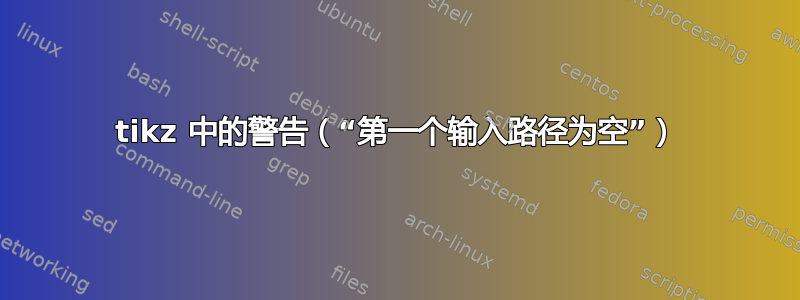
我正在尝试填充两条曲线之间的区域。理想情况下,我想要做的已经得到解答这里,但我收到以下警告(两次):
Package pgf Warning: fill between skipped: the first input path is empty. on input line 48.
这是我迄今为止尝试过的
\documentclass{article}
\usepackage{tikz,graphicx}
\usepackage{pgfplots, pgfplotstable}
\usepgfplotslibrary{statistics}
\usepgfplotslibrary{fillbetween}
\usetikzlibrary{patterns,intersections}
\pgfplotsset{compat=newest}
\usetikzlibrary{babel}
\begin{document}
\begin{figure}%[ht]
\centering
\begin{tikzpicture}
\begin{axis}[
xmin=-2,xmax=7,
ymin=0,ymax=1.5,
axis x line=middle,
axis y line=middle,
axis line style=-,
xlabel={$x$},
ylabel={$y$},
]
% parte negra de f1
\addplot[no marks,black,-] expression[domain=-2:3,samples=100]{exp(-0.5*(x-2)^2)}
node[pos=-0.5,anchor=north east]{};
% parte negra de f2
\addplot[no marks,black,-] expression[domain=3:7,samples=100]{exp(-0.5*(x-4)^2)}
node[pos=-0.5,anchor=north east]{};
% parte azul de f1
\addplot+[no marks,blue,thick,-] [name path=f1,domain=3:7,samples=1000]{exp(-0.5*(x-2)^2)}
node[pos=0,anchor=north east]{};
% parte azul de f2
\addplot[no marks,blue,thick,-] expression[name path=f2,domain=-2:3,samples=1000]{exp(-0.5*(x-4)^2)}
node[pos=0,anchor=north east]{};
\draw (2,1) ++(90:0.2cm) ++(90:0.25cm) node [fill=none](fk1){$f_1(x)$};
\draw (4,1) ++(90:0.2cm) ++(90:0.25cm) node [fill=none](fk2){$f_2(x)$};
% eje x
\addplot[name path=xAxis,const plot,thick,no marks,draw=none] coordinates {(0,0) (1,0)};
\addplot[blue!20!white] fill between[of=f1 and xAxis,soft clip={domain=3:7}];
\addplot[blue!20!white] fill between[of=f2 and xAxis,soft clip={domain=-2:3}];
\end{axis}
\end{tikzpicture}
\caption{Función logística o sigmoidal}
\label{fig:Two plots}
\end{figure}
\end{document}
应该呈现
蓝色部分下方的区域已填充。作为奖励,我希望 x 标签不会与曲线相撞。有什么想法可以添加“name path global=axis”吗?
答案1
我认为我可以提出一种更简单的方法来实现您的目标。有关更多详细信息,请查看代码中的注释。
% used PGFPlots v1.14
\documentclass[border=5pt]{standalone}
\usepackage{pgfplots}
\usepgfplotslibrary{fillbetween}
\pgfplotsset{
% use this `compat' level or higher so you don't need to specify
% `axis cs:' any more at each TikZ coordinate
compat=1.11,
% declare the functions here so it is easy to calculate the positions
% of the labels as well
/pgf/declare function={
f1(\x) = exp(-0.5*(\x-2)^2);
f2(\x) = exp(-0.5*(\x-4)^2);
},
}
\begin{document}
\begin{tikzpicture}
\begin{axis}[
xmin=-2,xmax=7,
ymin=0,ymax=1.5,
% I changed that from `middle' to `bottom', so that also the 0
% is shown as label ...
axis x line=bottom,
axis y line=middle,
axis line style=-,
xlabel={$x$},
ylabel={$y$},
xlabel style={
% ... but because of that you need to re-position `xlabel' and
% the corresponding node anchor if it should be on the end of
% the x-axis
at={(xticklabel cs:1)},
anchor=south east,
},
% use this key to draw the axis lines over the other stuff
axis on top,
% moved all common `\addplot' options here
no markers,
domain=-2:7,
samples=101,
]
% you only need to plot the functions once
% (and of course you can use the above defined functions here)
\addplot [name path=f1] {f1(x)};
\addplot [name path=f2] {f2(x)};
% and of course you can also use the declared functions to calculate
% the proper position of the labels
% (as stated above, using `compat=1.11' or higher you don't need
% to state, e.g. `(axis cs:2,{f1(2)})' any more)
\node [anchor=south] at (2,{f1(2)}) {$f_1(x)$};
\node [anchor=south] at (4,{f2(4)}) {$f_2(x)$};
% even simpler than using an `\addplot' command here is just
% specifying a path
% You can use the following line when you explicitly have set the
% `xmin' and `xmax' values. ...
% (Of course you can also call this values in `\addplot coordinates')
\path [name path=xAxis] (\pgfkeysvalueof{/pgfplots/xmin},0)
-- (\pgfkeysvalueof{/pgfplots/xmax},0);
% % ... In case `xmin' and `xmax' are not specified, you can use
% % the following to achieve the same result
% \path (rel axis cs:0,0) |- (0,0) node [coordinate] (xmin) {};
% \path (rel axis cs:1,0) |- (0,0) node [coordinate] (xmax) {};
% \path [name path=xAxis] (xmin) -- (xmax);
% now you can immediatly draw the thick black line using the
% `sequence' feature of the `fillbetween' library to which you also
% give a name to later use it to fill the area below it
\draw [
name path=lower,
draw=blue,
thick,
% this is an option from the `fillbetween' library of PGFPlots
% to create a path along the curves from intersection point to
% intersection point
intersection segments={
of=f1 and f2,
sequence=R1 -- L2,
},
];
% doing the stuff above now it is very easy to fill the area under
% the blue line
\addplot [blue!20!white] fill between [of=lower and xAxis];
\end{axis}
\end{tikzpicture}
\end{document}
答案2
我认为您只想剪辑第二条路径。
\documentclass{standalone}
\usepackage{pgfplots}
\usepgfplotslibrary{statistics,fillbetween}
\usetikzlibrary{patterns,intersections}
\pgfplotsset{compat=newest}
\usetikzlibrary{babel}
\begin{document}
\begin{tikzpicture}
\begin{axis}[
xmin=-2,xmax=7,
ymin=0,ymax=1.5,
axis x line=middle,
axis y line=middle,
axis line style=-,
xlabel={$x$},
ylabel={$y$},
]
% parte negra de f1
\addplot[no marks, black, -] expression [domain=-2:3, samples=100] {exp(-0.5*(x-2)^2)} node [pos=-0.5,anchor=north east]{};
% % parte negra de f2
\addplot[no marks, black, -] expression [domain=3:7, samples=100] {exp(-0.5*(x-4)^2)} node [pos=-0.5, anchor=north east]{};
parte azul de f1
\addplot+[no marks, blue, thick, -, name path=f1, domain=3:7, samples=1000] expression [] {exp(-0.5*(x-2)^2)} node [pos=0,anchor=north east]{};
% parte azul de f2
\addplot+[no marks, blue,thick, -, name path=f2, domain=-2:3, samples=1000] expression [] {exp(-0.5*(x-4)^2)} node [pos=0, anchor=north east]{};
\draw (2,1) ++(90:0.2cm) ++(90:0.25cm) node [fill=none](fk1){$f_1(x)$};
\draw (4,1) ++(90:0.2cm) ++(90:0.25cm) node [fill=none](fk2){$f_2(x)$};
% manual p. 429
\path [name path=xAxis] (\pgfkeysvalueof{/pgfplots/xmin},0) -- (\pgfkeysvalueof{/pgfplots/xmax},0);
% manual p. 431
\addplot [blue!20!white] fill between[of=f1 and xAxis, soft clip second={domain=3:7}];
\addplot [blue!20!white] fill between[of=f2 and xAxis, soft clip second={domain=-2:3}];
\end{axis}
\end{tikzpicture}
\end{document}





